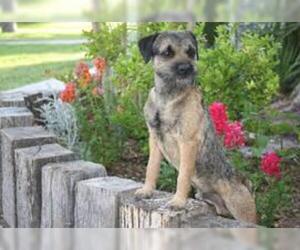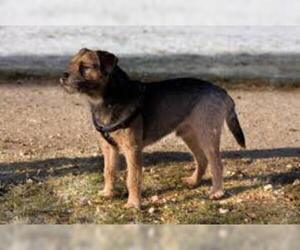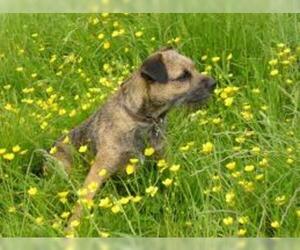
All about Border Terrier dog breed
A.K.A. :Coquetdale Terrier, Reedwater Terrier, Roxburghshire Terrier, Border, Borders, BW.
Size
Grooming requirements
Exercise requirements
Good with other dogs
Watchdog ability
Energetic
Training requirements
Playful
Affectionate
Good with other pets
Good with children
Good with strangers
Winter
Summer
Healthiness
Protective
Life Span
| Pure Breeds | Member |
| Breeds A - Z | B |
| Breeds by Group | Terrier |
| Breeds by Trait | Good With Kids Hypoallergenic Low Shedding Smartest Dog Breeds |
| Overview: | The Border Terrier, originating from the Anglo-Scottish border region, was bred to work alongside huntsmen, bolting foxes and other vermin. This small, hardy terrier possesses a distinctive "otter-like" head, a wiry, dense coat that provides excellent weather protection, and a lean, muscular build. Typically weighing between 11-15 pounds, they are incredibly agile and possess surprising stamina. Known for their alert and affectionate temperament, Border Terriers are generally good-natured and can be wonderful family pets, often getting along well with children and other animals when properly socialized. While adaptable, their natural inclination to dig and chase means secure fencing is essential. They can thrive in apartments if given sufficient daily exercise and mental stimulation. Health-wise, they are generally robust, but like many breeds, can be prone to certain conditions such as Canine Epileptoid Cramping Syndrome (CECS) and luxating patellas, making responsible breeding practices crucial. |
F.A.Q.
All You Need to Know About the Border Terrier Breed
The Border Terrier, originating from the Anglo-Scottish border, is a small, hardy, and intelligent dog, historically bred for hunting fox and vermin. Known for their alert, plucky, and affectionate temperament, they make excellent companions for active families. Their distinctive "otter head" and wiry, low-shedding coat require weekly brushing and occasional hand-stripping to maintain. Border Terriers are generally good with children and other pets when properly socialized, making them suitable for various living situations, including apartments, provided they receive adequate daily exercise—think brisk walks and playtime. They are bright and eager to please, making training relatively straightforward, though their terrier instincts mean they may chase small animals. Common health considerations include luxating patella and various eye conditions, but generally, they are a robust breed with a lifespan of 12-15 years. Choose a Border Terrier for a loyal, energetic, and charming addition to your home!The average weight for an adult Border Terrier is typically between 11.5 to 15.5 pounds. While there isn't a significant weight difference between males and females, males may sometimes be slightly heavier within this range. This is considered the healthy weight for a Border Terrier, reflecting their compact and agile build.
Curious about the Border Terrier height or how tall is a Border Terrier? Here's what you need to know about their average size:
Average Border Terrier Height: Approximately 11-14 inches at the Shoulder
The average height of a Border Terrier, measured at the shoulder (withers), typically falls between 11 and 14 inches (approximately 28-36 cm). This makes them a compact and sturdy little dog, perfect for active families looking for a medium-small companion.Typical Adult Height Range:
- Males: Generally range from 12 to 14 inches.
- Females: Often a bit smaller, typically 11 to 13 inches.
Border Terrier Colors: A Guide to Coat TypesBorder Terriers come in a charming array of colors, with several officially recognized by major kennel clubs like the AKC and others considered rare or exotic variations. When considering Border Terrier colors, potential adopters or buyers should be aware of these distinctions, as they can sometimes influence availability and pricing.AKC Recognized Border Terrier Colors: The American Kennel Club (AKC) officially recognizes several Border Terrier colors. These are the most common and widely accepted coat types you'll encounter.* Grizzle & Tan: This is perhaps the most iconic and prevalent Border Terrier color. It features a mix of black, white, and brown hairs on the body, giving a grizzled appearance, with tan markings on the legs, head, and under the tail.* Blue & Tan: Similar to grizzle & tan, but with a distinct steel-blue shade to the body coat, contrasted with tan markings. This is a very popular and striking AKC recognized Border Terrier color.* Red: Ranging from a deep foxy red to a lighter wheaten red. This solid color can be quite vibrant and appealing.* Wheaten: A paler, golden-tan color, reminiscent of wheat. This is another lovely and recognized solid color.Rare and Exotic Border Terrier Variations: While the above are the standard AKC recognized Border Terrier colors, occasionally you may encounter rare coat types or exotic Border Terrier variations. It's important to note that these are generally not accepted in the show ring by major kennel clubs and may indicate mixed lineage or unique genetic traits.* Fawn: While sometimes seen, a true, uniform fawn is less common than the recognized colors and typically falls within the "wheaten" spectrum for show purposes.* Cream or White Markings: While not a primary color, excessive cream or white markings outside of the recognized patterns are considered faults in the show ring.* Brindle: True brindle patterns (stripes of different colors) are not a recognized Border Terrier color by the AKC, though some grizzle coats can appear somewhat brindled.* Blue, Lilac, Merle, Chocolate: These are exotic Border Terrier variations that are not found in purebred Border Terriers from established lines. If a Border Terrier is advertised with these colors, it strongly suggests a mixed breed origin. Reputable breeders adhere to the breed standard and will not produce these colors. Buyers interested in such rare coat types should be cautious and inquire about lineage and health clearances, as some of these colors can be linked to genetic health issues in other breeds.Understanding these distinctions in Border Terrier colors will help you make an informed decision when searching for your next Border Terrier companion. Focus on reputable breeders who adhere to breed standards and prioritize health and temperament alongside coat color.
The Border Terrier personality is generally friendly, intelligent, and loyal. They are sociable and enjoy being part of the family, forming strong bonds with their owners. While adaptable, their energetic nature means apartment living can be suitable if they receive sufficient daily exercise and mental stimulation. Regarding children, they are typically good-natured and playful, often getting along well, though supervision is always recommended with any dog and young children. Their instinctual prey drive can make them challenging with other small pets like hamsters or rabbits, but they can coexist peacefully with other dogs if properly socialized from a young age. Their temperament of Border Terrier is characterized by a charming blend of pluckiness and affection.
The Border Terrier temperament is generally described as plucky, affectionate, and alert. They are a loyal companion dog that forms strong bonds with their families. Friendliness towards people is common, making them quite sociable, though they may be reserved with strangers initially. Adaptability to apartment living is possible if they receive sufficient daily exercise, but a yard is preferred. They are known to be good with children who understand how to interact respectfully with dogs, showing patience and a playful nature. However, their strong prey drive can make behavior with other pets, especially small furry ones, challenging without early socialization and training. They can live peacefully with other dogs if introduced carefully. Border Terriers possess a degree of stubbornness, a characteristic terrier trait, which requires consistent, positive reinforcement training. They are not overly sensitive, but respond best to fair and clear guidance rather than harsh methods. Expect an intelligent and lively personality in this spirited breed.
Border Terrier Care: Your Daily Maintenance GuideBorder Terrier care involves relatively straightforward routines. This low-energy dog breed thrives on consistent, but not excessive, activity. They are generally robust but require attention to specific areas for optimal health.Grooming Needs: Border Terriers have a wiry, double coat that requires hand-stripping 2-3 times a year to remove dead hair and maintain coat quality. Avoid clipping, as it softens the coat and can lead to skin issues. Regular brushing 1-2 times a week helps remove loose hair and dirt.Exercise Limitations: While not a high-energy breed, Border Terriers need daily walks and opportunities to explore. Aim for at least 30-60 minutes of moderate exercise per day. They are keen on scent work and enjoy interactive play. Due to their strong prey drive, always keep them on a leash in unfenced areas.Dietary Considerations: Feed a high-quality, balanced dog food appropriate for their age, size, and activity level. Monitor their weight closely as they can be prone to obesity. Consult your vet for specific dietary recommendations and portion control.Wrinkle and Ear Cleaning: Border Terriers do not have significant skin folds or wrinkles that require special cleaning. Their ears should be checked weekly for redness, odor, or discharge, and cleaned gently with a vet-approved solution if necessary.Climate Sensitivity (Brachycephalic Anatomy): Important Note: Border Terriers are NOT a brachycephalic breed. They have a standard muzzle length and typically tolerate various climates well. However, like any dog, they should not be left in extreme heat or cold. Provide fresh water and shade in warm weather.Common Health Concerns & Health Tips for Border Terrier:* Skin Issues: Due to their wiry coat, some Border Terriers can be prone to skin allergies or irritations if not properly groomed (e.g., clipping instead of hand-stripping).* Dental Care: Regular dental care is crucial. Brush their teeth several times a week and provide dental chews to prevent plaque and tartar buildup. Professional dental cleanings may be necessary.* Weight Management: Border Terriers can gain weight easily. Monitor their food intake and ensure sufficient exercise to prevent obesity, which can lead to other health problems.* Luxating Patella: A common orthopedic issue in many small breeds.* Heart Conditions: Regular veterinary check-ups are essential for early detection of any heart murmurs or conditions.Understanding how to care for a Border Terrier will ensure your companion lives a long, happy, and healthy life. Regular veterinary check-ups are paramount for early detection and prevention of common ailments.
The Border Terrier activity level is moderate to high, making them a surprisingly energetic companion for their size. These terriers are built for stamina and have significant exercise needs. They typically enjoy short bursts of intense activity followed by long periods of rest. Daily, they require at least 60 minutes of vigorous exercise, which can include brisk walks, jogging, hiking, or off-leash play in a secure area. They love to chase and dig, so playtime preferences often involve games of fetch, hide-and-seek, and exploring.Despite their terrier drive, it's important to note the limitations due to their brachycephalic anatomy. While not as pronounced as some other brachycephalic breeds, Border Terriers can still be prone to overheating, especially in hot weather or during strenuous exercise. Always monitor them for signs of distress and ensure access to water. They are known for their ability to balance high-energy play with downtime, often content to snuggle on the couch after a good workout.So, how active are Border Terrier? They are generally suitable for active families who can provide consistent daily exercise and mental stimulation. They are not well-suited for low-energy households unless those households are prepared to commit to their significant exercise requirements. Their intelligence and desire to work mean they excel in dog sports like agility and earthdog trials.
Breed Breakdown: What Experts Say About the Border Terrier
I'd rate the "Size" trait of the Border Terrier a 3 out of 10.They are a small, compact breed, typically weighing between 11.5 to 15.5 pounds and standing around 11 to 14 inches tall at the shoulder. Their sturdy, wiry build makes them surprisingly robust for their size, but they are definitively on the smaller end of the canine spectrum, especially when compared to most other companion dogs. This small stature makes them exceptionally well-suited for apartment living, travel, and households with space constraints. They can comfortably curl up in small spaces and are easily transportable, fitting into pet carriers for planes or cars without much hassle.
I would rate the Border Terrier's "Grooming Requirements" a 4 out of 10.While not completely "wash and wear," Border Terriers are generally considered a low-to-moderate maintenance breed compared to many other companion dogs. Their wiry, double coat is designed to be weather-resistant and sheds minimally, requiring hand-stripping a few times a year (typically 2-4 times) to maintain its texture and health, rather than extensive daily brushing or professional clipping. This hand-stripping can be done by a professional groomer or learned by the owner, but it's a specific technique that sets them apart from breeds that simply need a trim. Beyond that, regular brushing (a few times a week) helps remove loose hair and dirt, and while they don't have skin folds, routine ear cleaning, nail trimming, and occasional bathing (only when truly dirty, as frequent bathing can soften the coat) are standard for all dogs. They are not particularly prone to skin issues or allergies, making their overall care fairly straightforward once the stripping routine is established. They are easy to care for, with the main "specialized" aspect being the hand-stripping, which isn't as frequent as the daily grooming demands of many longer-coated breeds.
I'd rate the Border Terrier's "Exercise Requirements" at a 7.While not in the same league as a Border Collie or a Malinois, Border Terriers are far from couch potatoes. They are a tenacious, hardy working breed with surprising endurance for their size. Their energy levels are consistently high, and they possess a strong prey drive and an adventurous spirit, meaning they thrive on sustained movement. They are not brachycephalic, so they don't have the same respiratory limitations as some other terrier breeds, allowing them to engage in longer periods of activity. Daily activity recommendations usually include at least an hour of brisk walking, but many Borders will happily go for much longer. They excel in activities like long hikes, off-leash exploration in secure areas, playtime involving chasing and digging, and dog sports like agility, earthdog trials, and even obedience. They require structured routines to stay both physically healthy and, crucially, mentally stimulated; a bored Border Terrier with pent-up energy is more likely to engage in destructive behaviors or excessive barking. While they can adapt to a slightly less active lifestyle with a very dedicated owner who provides ample mental engagement, they are happiest and most well-behaved when given regular, vigorous exercise that allows them to use both their bodies and their sharp minds.
I'd rate the Border Terrier's "Watchdog Ability" at a 7 out of 10.Border Terriers are surprisingly effective watchdogs for their size. They are naturally alert and observant, possessing keen senses of hearing and smell honed by their working heritage. They are quick to pick up on unusual sounds or the presence of unfamiliar people approaching the home, and their barking behavior is typically prompt and enthusiastic in such situations. This isn't a passive "let's see what happens" dog; they have a strong territorial instinct within their home environment. While they aren't typically aggressive guard dogs, their initial loud and persistent barking serves as an excellent early warning system. They will certainly make their presence known and are quite capable of deterring opportunistic intruders by creating a significant racket, even if they wouldn't engage in a physical confrontation. They are definitely more than just a passive companion when it comes to home security.
I would rate the Border Terrier's "Good with Other Dogs" trait a 6 out of 10.While not inherently aggressive, Border Terriers are terriers, and that means they possess a strong prey drive and a confident, sometimes assertive, personality. They are generally tolerant of other dogs when properly socialized from a young age, and many enjoy the company of canine companions, especially those within their own household. However, their independent nature and historical role as vermin hunters can lead to a less forgiving attitude towards unfamiliar dogs, particularly if those dogs are pushy or challenge their space. They may not always be the most enthusiastic players with every dog they meet and can be selective. Compatibility with dogs of different sizes and energy levels can vary; they might struggle with very boisterous dogs who don't respect their boundaries or very timid dogs they might inadvertently overwhelm. Multi-dog households can certainly work well, especially with early introductions and consistent training, but owners need to be prepared for the possibility of occasional squabbles or a need for careful management, especially during feeding times or when high-value resources are present. They typically require careful introductions and ongoing socialization to coexist peacefully, rather than naturally thriving in all canine company without guidance.
I would rate the Border Terrier's "Energetic" trait at an 8 out of 10.The Border Terrier is a highly active and tenacious breed, bred for working in the rugged border regions of England and Scotland. They possess a remarkable amount of stamina and a strong prey drive, making them enthusiastic participants in a wide range of outdoor activities. Their typical activity level is high, requiring regular, vigorous exercise to keep them happy and well-behaved. They are incredibly playful and enjoy games of fetch, tug, and chasing. This breed has a great capacity for endurance and can easily keep up with active families on long walks, hikes, or runs. They have a significant need for physical and mental stimulation, and if not adequately exercised, can become bored and destructive. Compared to many companion dogs, they are naturally very active and require more than just a casual stroll around the block. Their brachycephalic anatomy does not apply to Border Terriers; they have a distinct, longer muzzle that allows for efficient breathing and excellent exercise tolerance, unlike true brachycephalic breeds such as Pugs or Bulldogs. This anatomical feature contributes to their high energy and ability to participate in demanding physical activities without significant respiratory limitations.
I would rate the Border Terrier's "Training Requirements" at a 6 out of 10.While intelligent, Border Terriers possess a strong independent streak and the characteristic terrier stubbornness that can make training a consistent effort. Their attention span, especially as puppies or when highly stimulated, can be short, requiring engaging and varied training sessions. They are generally responsive to commands once they understand what's expected, but their ingrained prey drive and desire to explore can often override a command if something more interesting presents itself. Consistency is absolutely paramount; a Border Terrier will quickly exploit any lapse in rules or commands. Positive reinforcement is highly effective, as they are food-motivated and eager to please their human, but it needs to be delivered promptly and enthusiastically.This breed is not typically beginner-friendly when it comes to training. While a dedicated and consistent first-time owner can succeed, the Border Terrier truly benefits from experienced handling and structured routines from day one. Their tendency to chase and dig, combined with their sometimes selective hearing, means that early and consistent leash training, recall, and impulse control are crucial for a well-behaved adult. Without clear boundaries and consistent expectations, they can quickly develop undesirable habits.
I would rate the Border Terrier's "Playful" trait a strong 8 out of 10.Border Terriers are naturally spirited and possess a zest for life that is evident in their daily interactions. They have a surprisingly high activity level for their size and genuinely love to engage in games, whether it's a vigorous round of fetch or a mentally stimulating puzzle toy. Their attention-seeking behavior often manifests as nudges, playful barks, or bringing you their favorite toy, clearly signaling their desire for interaction. They respond to toys and playtime with remarkable enthusiasm, often appearing to smile as they chase, retrieve, and "kill" their prey. While not as relentlessly energetic as some working breeds, they are far from laid-back and consistently demonstrate an eagerness for fun and companionship, making them incredibly engaging and entertaining companions.
I would rate the Border Terrier's "Affectionate" trait a 7 out of 10. They are undeniably loyal and form strong bonds with their families, demonstrating a clear desire for human companionship and often following their owners from room to room. They are also sensitive to owner emotions, often offering a comforting presence. However, compared to some other companion breeds, they maintain a degree of independence. While they enjoy a good cuddle, especially on their own terms, they aren't typically extreme lap dogs and might not demand constant physical closeness. They appreciate affection but also possess a working terrier's self-reliance, thriving on a balance of attention and personal space rather than being solely defined by an insatiable need for cuddles.
I would rate the "Good with Other Pets" trait of the Border Terrier breed as a 6 out of 10.Border Terriers possess a moderate prey drive, particularly towards smaller, quick-moving animals like cats or rabbits, which is a significant factor in multi-pet households. While they are generally good-natured and can be quite sociable with other dogs, especially when properly introduced and socialized from a young age, their inherent instinct to chase can be a challenge. They are not naturally "cat-friendly" in the way some breeds are, and often require extensive, careful training and supervision to coexist peacefully with felines. Without this, a Border Terrier may see a cat as prey rather than a housemate. Resource guarding can occur, as with many breeds, but isn't typically extreme in Border Terriers if they are well-socialized and trained. They are adaptable in multi-pet households *if* the other pets are dogs of similar size or temperament, and *if* a strong foundation of training and management is established to mitigate their prey drive. They are not inherently extremely pet-friendly across the board and require deliberate effort and consistent supervision to ensure harmonious relationships with all types of other pets, particularly smaller ones.
I'd rate the Border Terrier's "Good with Children" trait a 6 out of 10.While generally not aggressive, they aren't instinctively exceptionally child-friendly either. Their temperament is a mix of independent terrier spirit and a surprising gentleness, but they also possess a strong prey drive and a busy, sometimes boisterous nature. They are often playful and can form strong bonds with older, respectful children who understand how to interact with a dog. However, their patience can wear thin with constant rough handling or very young, unpredictable toddlers. They are moderately tolerant of noise and handling, but might retreat if overwhelmed. Supervision is always recommended, especially with young children, to ensure both the dog and child learn appropriate boundaries. Early socialization and training are crucial to help a Border Terrier thrive in a family setting and encourage their more affectionate side to emerge, making them a good fit for active families who are willing to put in the effort.
I would rate the Border Terrier's "Good with Strangers" trait a 6 out of 10.While not inherently aggressive or fearful, the Border Terrier is generally reserved and discerning rather than overtly effusive with unfamiliar adults. They tend to be polite but not overly enthusiastic upon first meeting. Their terrier nature imbues them with a degree of independence and self-possession, meaning they often prefer to observe a new person before offering much in the way of affection. While they are not typically barkers at guests and are not generally prone to guarding, they also aren't the type to immediately solicit attention from everyone they encounter. With proper socialization, they are perfectly adaptable in public or guest-filled environments, remaining calm and well-behaved, but they aren't naturally outgoing in the way some breeds are. They generally require early and consistent socialization to ensure they are comfortable and accepting of new people, rather than being naturally predisposed to boundless friendliness with strangers.
I would rate the Border Terrier's "Winter" tolerance at a solid 7.While not built for arctic exploration, the Border Terrier possesses several attributes that give it a good level of cold-weather resilience. Their dense, wiry double coat provides excellent insulation against the cold and moisture, effectively repelling snow and rain. Despite their small size, they are surprisingly sturdy and well-muscled, giving them a decent surface-area-to-volume ratio compared to more delicate toy breeds. They are not brachycephalic, meaning their respiratory system is not compromised in cold air, reducing the risk of respiratory issues. Their energetic nature also helps them generate body heat through activity.However, they are not impervious to extreme cold. Their relatively small body size means they can lose heat more quickly than larger breeds if inactive or exposed to very low temperatures for extended periods. While their coat is good, it's not designed for prolonged exposure to sub-zero temperatures without breaks. Therefore, while they can safely enjoy outdoor activities in most cold climates, they will require some special care during very harsh winter months compared to, say, a Siberian Husky. This might include shorter outdoor excursions in extreme cold, the consideration of a dog coat for prolonged sedentary time outdoors or in very deep snow, and ensuring they have a warm, dry place to rest indoors after their adventures. They won't shiver after a quick romp in the snow, but a full day of ice fishing might be pushing it without proper precautions.
I would rate the Border Terrier's "Summer" tolerance at a 6.Border Terriers are generally quite hardy and active, but they are not built for extreme heat. Their dense, double coat, while excellent for protection in cooler weather, can make them prone to overheating in high temperatures. Unlike brachycephalic breeds, they don't have anatomical limitations to breathing, which is a significant advantage. However, like all dogs, they primarily regulate their body temperature through panting, and in very hot or humid conditions, this can be insufficient. They are at a moderate risk of heatstroke if over-exercised or left in warm environments without access to shade and water. During hot weather, outdoor activity levels should be significantly reduced and limited to cooler parts of the day, such as early mornings or late evenings. They definitely require special care in summer months compared to many other companion dogs, particularly those with short, single coats. While they don't necessarily need constant air conditioning like some more sensitive breeds, access to a cool indoor environment is essential, and close monitoring for signs of overheating is always recommended.
I would rate the Border Terrier's "Healthiness" trait as an 8 out of 10.The Border Terrier is generally considered a remarkably robust and healthy breed, particularly when compared to many other companion dogs. They boast a relatively long life expectancy for a dog of their size, often living into their early to mid-teens. While no breed is entirely free from genetic predispositions, Border Terriers are not widely known for a high incidence of severe, debilitating, or widespread breed-specific health issues like significant breathing difficulties, widespread joint problems, or chronic skin conditions that plague some other breeds. Their "hardy" terrier nature contributes to their resilience.However, the rating isn't a perfect 10 because they are not entirely immune to health concerns. Specific genetic predispositions, though less common than in some other breeds, include Canine Epileptoid Cramping Syndrome (CECS), also known as "Spike's Disease," which can be managed but is a concern. Other issues like luxating patella, various eye conditions (such as Progressive Retinal Atrophy), and certain allergies can occur, as they can in almost any breed. Responsible breeding practices, including health testing of parent dogs, are crucial in minimizing the prevalence of these issues. While not high-maintenance in terms of health, regular veterinary check-ups, a balanced diet, and appropriate exercise are still essential for maintaining their excellent health. Overall, they are generally a very healthy and resilient breed.
I would rate the Border Terrier's "Protective" trait at a 6 out of 10.While Border Terriers are incredibly alert and possess strong territorial instincts, their protective nature leans more towards being an excellent watchdog rather than a true guard dog. They are loyal to their owners and will certainly bark at anything or anyone they perceive as an intruder, making them highly effective at alerting the household to unusual activity. Their fearlessness and tenacity, stemming from their vermin-hunting heritage, mean they won't back down easily from a perceived threat, even if it's much larger than them. However, their size and typical temperament – which is more confident and friendly once they've assessed a stranger is not a threat – mean they are unlikely to inflict meaningful physical protection beyond their initial deterrent barking and brave stance. They are primarily companion dogs who excel at sounding the alarm, but their capacity to physically deter a serious threat is limited by their breed characteristics.
I would rate the "Life Span" trait of the Border Terrier breed a 9 out of 10.Border Terriers are renowned for their exceptional longevity, often living well into their teens. Their average life expectancy typically ranges from 12 to 15 years, and it's not uncommon to hear of individuals living even longer. This makes them a decidedly long-lived breed compared to many other companion dogs, especially those of similar size. While they can be prone to certain health issues like canine epileptoid cramping syndrome (CECS) and sometimes hip dysplasia, responsible breeding practices and generally robust genetics contribute to a strong foundation for a long life. They are generally a hardy and healthy breed, and with good care, nutrition, and regular veterinary check-ups, most Border Terriers enjoy a very extended and active lifespan.
Border Terrier Dogs for adoptionSee all dogs for adoption
Similar Dog Breeds for Border Terrier
Breed Mixes of Border Terrier
Quick Breed Selector 0 - not important, 1 - smallest, 10 - largest
Variants & Mistakes :Boarder Terrier, Boder Terrier, Border Terriar, Border Terrior, Border Terriore, Border Terriour, Border Tearrier, Border Tearier, Border Terryr, Border Terryer, Border Terryor, Bordar Terrier, Bordir Terrier, Bordor Terrier, Bordre Terrier, Bordur Terrier, Broder Terrier, Borrder Terrier, Bortder Terrier, Bortrder Terrier, Border Tereir, Border Terrer, Border Terir, Border Terreir, Border Terrir, Border Terierr, Border Teriier, Border Terrierre, Border Teriure, Border Tierrer, Border Tierier, Border Tyrrier, Border Tyrier, Border Tirrier, Border Tirier, Border Teryer, Borer Terrier, Bordr Terrier, Border Terier, Border Tyrrer, Border Tyerrier, Border TYerier, Border TErrirer






